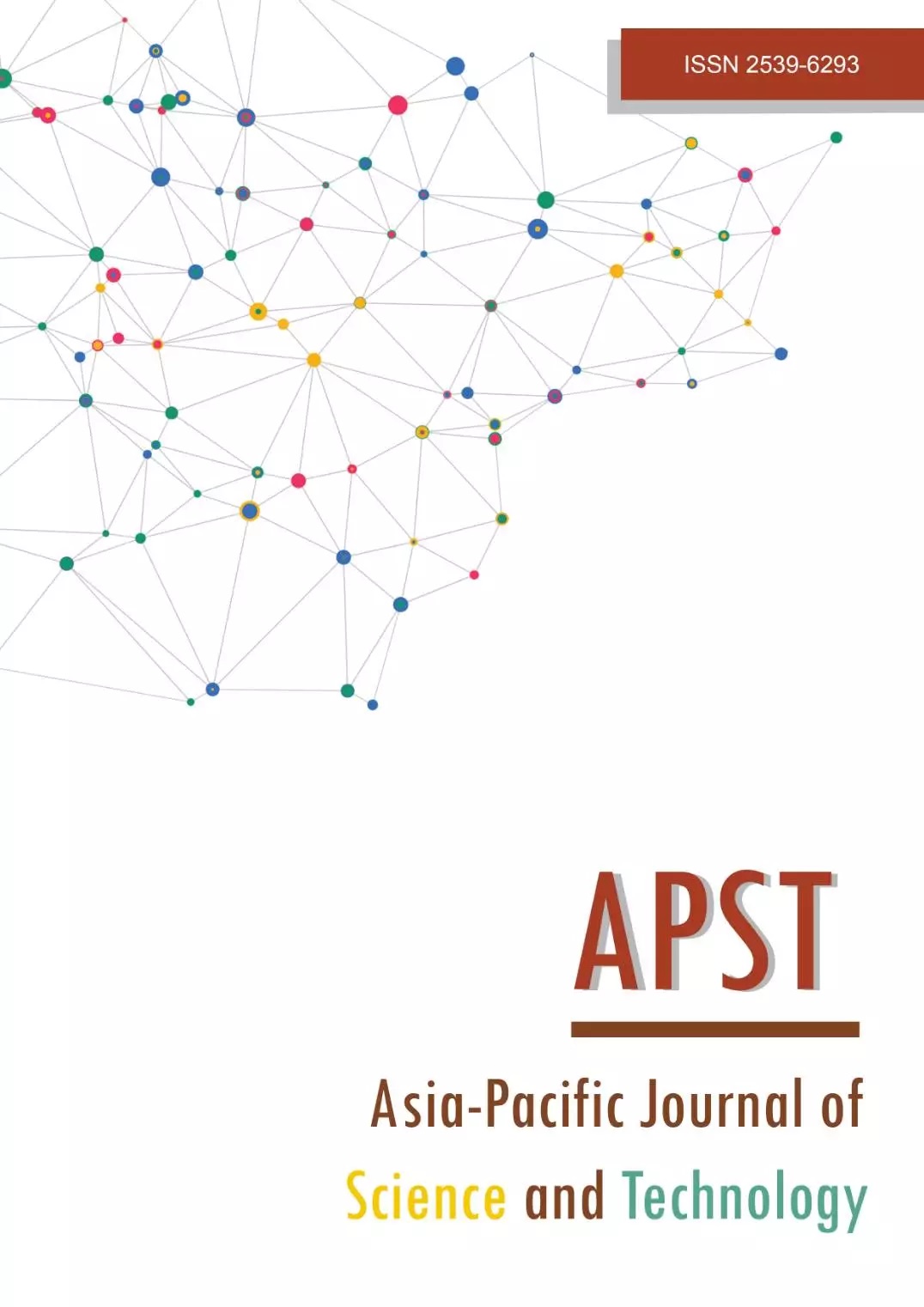Changes of daily rainfall intensity in Thailand from 1955 to 2019
Main Article Content
Abstract
Analysis of daily rainfall intensity in Thailand from 1955 to 2019 revealed remarkable changes in lower and upper distribution tails, highlighting a significant decrease in light rainfall events but a significant increase in heavy rainfall events. Leading patterns of trends in all ten rainfall categories for wet-season, dry-season and annual periods demonstrated that most areas of Thailand experienced increasing contribution of heavy rainfall events. Results also indicated a significant correlation between contribution trends of light and heavy rainfall events in Thailand and changes in global mean temperature (GMT), supporting the notion that increased heavy rainfall intensities at both local and national levels followed anthropogenic-induced increase in atmospheric moisture. Regression-based extrapolated values for future levels of global warming at 1.5 °C and 2 °C indicated that an additional half-degree of warming will result in almost a 50% increase in heavy rainfall events in Thailand. This study presents scientific information to support effective management of water in the agriculture sector and adapt to the impacts of climate-related extremes and disasters. Studies based on high-resolution simulated climate data and space and ground-based observations are important to better understand the associations between anthropogenic-induced effects, large-scale atmospheric circulation and local changes in Thailand’s rainfall intensity distribution, especially for daily and sub-daily time scales.
Article Details

This work is licensed under a Creative Commons Attribution-NonCommercial-NoDerivatives 4.0 International License.
References
Haerter JO, Berg P, Hagemann S. Heavy rain intensity distributions on varying time scales and at different temperatures. J Geophys Res. 2010;115:D17102.
Wu FT, Fu CB. Change of precipitation intensity spectra at different spatial scales under warming conditions. Sci Bull. 2013;58:1385-1394.
Westra S, Fowler HJ, Evans JP, Alexander LV, Berg P, Johnson F, et al. Future changes to the intensity and frequency of short-duration extreme rainfall. Rev Geophys. 2014;52:522-555.
Groisman PY, Knight RW, Easterling DR, Karl TR, Hegerl GC Razuvaev VN. Trends in intense precipitation in the climate record. J Clim. 2005;18:1326-1350.
Allan RP, Soden BJ. Atmospheric warming and the amplification of precipitation extremes. Science. 2008;321:1481-1484.
Min SK, Zhang X, Zwiers F, Hegerl GC. Human contribution to more-intense precipitation extremes. Nature. 2011;470:378-381.
Pendergrass AG, Hartmann DL. Changes in the distribution of rain frequency and intensity in response to global warming. J Clim. 2014;27:8372-8383.
Gorman PA. Precipitation extremes under climate change. Curr Clim Change Rep. 2015;1:49-59.
Held IM, Soden BJ. Robust responses of the hydrological cycle to global warming. J Clim. 2006;19:5686-5699.
Gorman PA, Schneider T. The physical basis for increases in precipitation extremes in simulations of 21st-century climate change. Proc Natl Acad Sci USA. 2009;106:14773-14777.
Chou C, Chen CA, Tan PH, Chen KT. Mechanisms for global warming impacts on precipitation frequency and intensity. J Clim. 2012;25:3291-306.
Allan RP, Liu C, Zahn M, Lavers DA, Koukouvagias E, Salcedo BA. Physically consistent responses of the global atmospheric hydrological cycle in models and observations. Surv Geophys. 2014;35:533-52.
Fischer EM, Knutti R. Observed heavy precipitation increase confirms theory and early models. Nat Clim Change. 2016;6:986-991.
Maraun D, Osborn TJ, Gillett NP. United Kingdom daily precipitation intensity: Improved early data, error estimates and an update from 2000 to 2006. Int J Climatol. 2008;28:833-842.
Donat MG, Alexander LV, Yang H, Durre I, Vose R, Dunn RJH, et al. Updated analyses of temperature and precipitation extreme indices since the beginning of the twentieth century: the HadEX2 dataset. J Geophys Res. 2013;118:1-16.
Westra S, Alexander LV, Zwiers FW. Global increasing trends in annual maximum daily precipitation. J Clim. 2013;26:3904-3918.
Myhre G, Alterskjær K, Stjern CW, Hodnebrog Ø, Marelle L, Samset BH, et al. Frequency of extreme precipitation increases extensively with event rareness under global warming. Sci Rep. 2019;9:16063.
Osborn TJ, Hulme M, Jones PD, Basnett TA. Observed trends in the daily intensity of United Kingdom precipitation. Int J Climatol. 2000;20:347-364.
Limsakul A, Singhruck P. Long-term trends and variability of total and extreme precipitation in Thailand. Atmos Res. 2016;169:301-317.
Eischeid JK, Baker CB, Karl TR, Diaz HF. The quality of long-term climatological data using objective data analysis. J Appl Meteorol. 1995;34:2787-2795.
Wang XL, Wen QH, Wu Y. Penalized maximal t test for detecting undocumented mean change in climate data series. J Appl Meteorol Climatol. 2007;46:916-931.
Wang XL. Penalized maximal F test for detecting undocumented mean shift without trend change. J Appl Meteorol Climatol. 2008;25:368-384.
Domonkos P. Homogenising time series: Beliefs, dogmas and facts. Adv Sci Res. 2011;6:167-172.
Hansen J, Ruedy R, Sato M, Lo K. Global surface temperature change. Rev Geophys. 2010;48:RG4004.
Sen PK. Estimates of the regression coefficient based on Kendall’s tau. J Am Stat Assoc. 1969;63:1379-1389.
Hameed KH, Rao AR. A modified Mann-Kendall trend test for autocorrected data. J Hydrol. 2008;204:182-196.
Jolliffe IT, Cadima J. Principal component analysis: A review and recent developments. Philos Trans Royal Soc A. 2016;374:20150202.
Miller AJ, Cayan DR, Barnett TP, Graham NE, Oberhuber JM. The 1976-77 climate shift of the Pacific Ocean. Oceanography. 1994;7:21-26.
Kokorev V, Ettema J, Siegmund P, van der Schrier G. Precipitation regime shift associated with the Pacific Decadal Oscillation in the Maritime Continent. Am J Clim. 2020;9:123-135.
Goswami BN, Venugopal V, Sengupta D, Madhusoodanan MS, Xavier PK. Increasing trend of extreme rain events over India in a warming environment. Science. 2006;314:1442-1445.
Wang L, Chen W. The East Asian Winter Monsoon: re-amplification in the mid-2000s. Sci Bull. 2014;59:430-436.
James R, Washington R, Schleussner CF, Rogelj J, Conway D. Characterizing half-a-degree difference: a review of methods for identifying regional climate responses to global warming targets. Wiley Interdiscip Rev Clim Change. 2017;8:e457.


